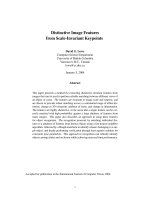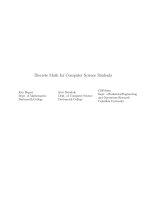Computer Science 1000
Bạn đang xem bản rút gọn của tài liệu. Xem và tải ngay bản đầy đủ của tài liệu tại đây (3.74 MB, 73 trang )
Computer Science 1000
Algorithms
Programs
we now have some idea on how computers execute
an instruction
a system of gates is connected to process a series of bits
in some fashion (e.g. adding binary numbers)
your processor has a list of instructions that it can
perform
arithmetic: adding, subtracting, etc …
memory operations: loading data from memory, saving
data to memory
and many others
Programs
the
language of the processor is binary
that
is, each instruction is a sequence of binary
digits
e.g. consider our example from term1.ppt
From the term1.ppt
slides.
CPU
– Basic Operation
read
an instruction
execute that instruction
repeat for next instruction
CPU
Memory
1
17
2
29
3
46
4
56
5
2576
Computer Program
0000100100010001
0000101000011101
0001001100101000
0000110000111000
0010010101110000
place value "17" in memory location 1
place value "29" in memory location 2
add values in loc. 1 and 2, place in loc. 3
place value "56" in memory location 4
multiply values in loc. 3 and 4, place in loc. 5
Programming
programming in binary is considerably difficult
fortunately, most software development today is
done using a high level programming language
C/C++, Java, Python, Visual Basic, etc.
a programming language represents a compromise
between natural language (human) and binary code
(computer)
Write program to compute the perimeter and area of a rectangle. The size of the
rectangle will be specified by the user.
#include <iostream>
using namespace std;
int main() {
int length;
cout << "Please enter the rectangle's length: ";
cin >> length;
From the term4.ppt
slides.
This is an example of a
computer program
written in C++.
int width;
cout << "Please enter the rectangle's width: ";
cin >> width;
int perimeter = 2 * (length + width);
int area = length * width;
cout << "The perimeter of the rectangle is " << perimeter << endl;
cout << "The area of the rectangle is " << area << endl;
return 0;
}
Algorithms
how does a program written in a programming language
become binary code that a processor can understand?
Answer: a compiler
a compiler is a program that creates other programs from highlevel code
int length;
cout << "Please enter the rectangle's
length: ";
cin >> length;
int width;
cout << "Please enter the rectangle's
width: ";
cin >> width;
int perimeter = 2 * (length + width);
int area = length * width;
cout << "The perimeter of the rectangle
is " << perimeter << endl;
cout << "The area of the rectangle is "
<< area << endl;
Compiler
0000100100010001
0000101000011101
0001001100101000
0000110000111000
0010010101110000
Programming
programs written in a programming language are
typically made up of a set of statements
roughly speaking, each statement defines an
operation that you would like the computer to
perform
output something to screen
perform a mathematical operation
save information to a file
send a request for a webpage to a server
etc …
Programming
Language
in many respects, programming languages are
similar to a natural language
only accepts certain keywords
for example, the word while in C++ creates a loop, the word
kev has no meaning to C++
statements have a particular syntax that must be followed
blocks of code must be enclosed in { }
statements must end with a semicolon
Programming
given a problem, a programmer’s task is to:
devise an algorithm for solving that problem
translate that algorithm into source code
compile the source code into a program that the computer
can understand
our topic for this week is to consider this task
in other words, a light introduction to programming
our programming language: Scratch
Scratch
a programming language and
environment written by MIT Labs
originally intended to introduce
children to programming, Scratch
has become a popular choice for
introducing programming in other
settings (e.g. universities)
freely available (GPL)
Source code
(source pane)
Available
operations.
Output
Scratch
in
“Code”
most programming languages, code is
written as text
in Scratch, operations are represented as
blocks
programs are arranged as sequences of
blocks arranged together
Source code
blocks.
Sprites
the
operations in Scratch control the
behaviour of the sprite
different operations available
moving/turning
sprite
output (as a text bubble)
sounds (drums, etc)
etc …
Scratch
– First Example
write
a program where the sprite says
“Hello!”
solution:
find
the following block
under the Looks category
drag
this block onto the source code pane
Scratch
write
– First Example
a program where the sprite says “Hello
World”
Scratch
to
– First Example
run the program, double click on the
block
to reset the program (remove output), click
the stop sign in the top right corner









